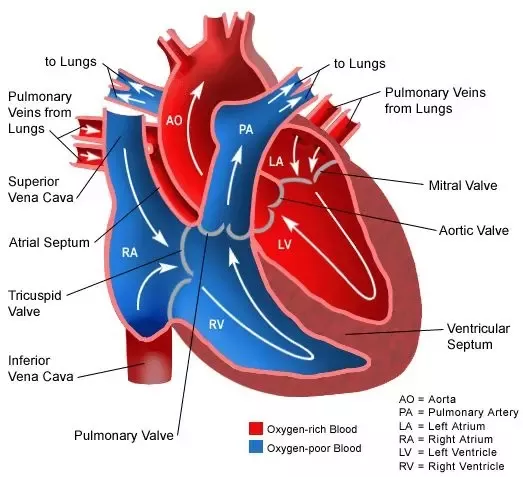The human heart works like a pump, sending blood throughout your body to keep you alive. It’s a muscle, about the size of your fist, located in the middle of your chest, slightly tilted to the left.
What is the Function of the Human Heart?
Each day, your heart beats around 100,000 times, pumping about five liters (eight pints) of blood through a network of blood vessels called your circulatory system. This blood delivers oxygen and nutrients to all parts of your body, helping your organs and muscles function properly, and also carries away unwanted carbon dioxide and waste products.
What is the Structure of the Human Heart?
Your heart is divided into a left side and a right side, separated by a thin muscular wall called the septum. Each side has an upper chamber and a lower chamber.
- The upper chambers are called the left atrium and the right atrium (or atria).
- The lower chambers are called the left ventricle and the right ventricle.
The right side of your heart receives de-oxygenated blood from your body and pumps it to your lungs to collect fresh oxygen. The left side of your heart pumps the oxygenated blood back throughout your body.
Layers of the Heart Muscle
Your heart muscle consists of three layers of tissue:
- Pericardium: A thin outer lining that protects and surrounds your heart.
- Myocardium: A thick, muscular middle layer that contracts and relaxes to pump blood.
- Endocardium: A thin inner layer lining the four chambers and valves of your heart.
What Does the Heart’s Electrical System Do?
Your heart’s electrical system regulates the contractions and relaxations that keep your blood pumping. The sinus node, your heart’s natural pacemaker, sends electrical signals to ensure a steady heartbeat, which can change based on your emotions and activity level—this is your heart rate.
How Does Blood Flow Around the Heart and the Body?
Your heart is part of a circulatory system that includes arteries, veins, and capillaries.
- Arteries deliver oxygen-rich blood from the heart to the body.
- Veins return de-oxygenated blood from the body to the heart.
- Capillaries connect arteries and veins.
Blood flows in one direction, controlled by heart valves that act like doors opening and closing with every heartbeat. The heart has four valves:
- Right side: Tricuspid valve and pulmonary valve.
- Left side: Mitral valve and aortic valve.
How Do Your Heart and Lungs Add Oxygen to Your Blood?
Blood is re-oxygenated in the lungs before being pumped to the rest of the body:
- The right atrium receives low-oxygen blood from the body and pumps it to the right ventricle.
- The right ventricle pumps this blood to the lungs for oxygen.
- The left atrium receives oxygen-rich blood from the lungs and pumps it to the left ventricle.
- The left ventricle pumps this oxygenated blood to the rest of the body.
What are Heart and Circulatory Diseases?
When the heart and circulatory system malfunction, it can lead to cardiovascular diseases, including:
- Coronary heart disease (heart attack and angina)
- Congenital heart disease
- Inherited heart conditions
- Stroke
- Vascular dementia
- Diabetes
What Causes Heart and Circulatory System Problems?
Heart and circulatory problems, such as heart attacks and strokes, often result from a buildup of fatty material (atheroma) in the arteries. This buildup narrows the arteries, restricting blood flow to the heart and brain.
Risk Factors for Heart and Circulatory Disease
Common risk factors include:
- Poorly managed diabetes
- High blood pressure
- High cholesterol
- Being overweight or obese
- Smoking
- Excessive alcohol consumption
For those seeking first aid courses in Perth, first aid course Perth, or CPR training Perth, ONEU Health Solutions provides comprehensive training to help you stay prepared for any health emergencies.
